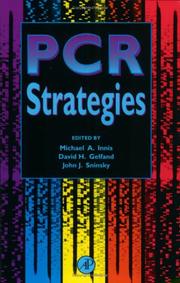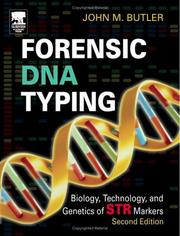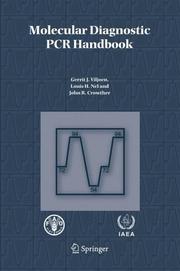| Listing 1 - 10 of 10 |
Sort by
|
Book
ISBN: 0128042311 012804246X 9780128042465 9780128042311 Year: 2017 Publisher: Amsterdam, [Netherlands] : Academic Press,
Abstract | Keywords | Export | Availability | Bookmark
 Loading...
Loading...Choose an application
- Reference Manager
- EndNote
- RefWorks (Direct export to RefWorks)
Polymerase chain reaction. --- Chain reaction, Polymerase --- PCR (Biochemistry) --- Polymerization --- DNA polymerases
Book
ISBN: 0128026839 0128026979 9780128026977 9780128026830 Year: 2017 Publisher: London, England : Academic Press,
Abstract | Keywords | Export | Availability | Bookmark
 Loading...
Loading...Choose an application
- Reference Manager
- EndNote
- RefWorks (Direct export to RefWorks)
Polymerase chain reaction --- Methodology. --- Chain reaction, Polymerase --- PCR (Biochemistry) --- Polymerization --- DNA polymerases
Book
ISBN: 9535153005 9535106120 Year: 2012 Publisher: IntechOpen
Abstract | Keywords | Export | Availability | Bookmark
 Loading...
Loading...Choose an application
- Reference Manager
- EndNote
- RefWorks (Direct export to RefWorks)
This book is intended to present current concepts in molecular biology with the emphasis on the application to animal, plant and human pathology, in various aspects such as etiology, diagnosis, prognosis, treatment and prevention of diseases as well as the use of these methodologies in understanding the pathophysiology of various diseases that affect living beings.
Polymerase chain reaction. --- Chain reaction, Polymerase --- PCR (Biochemistry) --- Polymerization --- DNA polymerases --- Biochemistry
Book
ISBN: 1608053482 9781608053483 Year: 2012 Publisher: Sharjah Bentham Science Publishers
Abstract | Keywords | Export | Availability | Bookmark
 Loading...
Loading...Choose an application
- Reference Manager
- EndNote
- RefWorks (Direct export to RefWorks)
PCR (Polymerase Chain Reaction) technology has become an indispensable component of routine veterinary diagnostics. However, a number of pitfalls and limiting factors affect its sensitivity and specificity of detection. It is imperative that veterinary PCR diagnosticians include such considerations in their work. Extensive experience with PCR technology in both research and diagnostic applications enables researchers to pinpoint these practical limitations, and therefore instruct the user in approaches that avoid these common errors.This E-book discusses the basic concepts, chemistries, and in
Polymerase chain reaction --- Polymerase chain reaction. --- DNA probes. --- Microorganisms --- Deoxyribonucleic acid probes --- Gene probes --- Genomic probes --- Probes, DNA --- Deoxyribonucleotides --- Nucleic acid probes --- Chain reaction, Polymerase --- PCR (Biochemistry) --- Polymerization --- DNA polymerases --- Molecular diagnosis --- Diagnostic use.

ISBN: 9780123721822 0123721822 9786611046569 1281046566 0080538541 9780080538549 9781281046567 6611046569 0123721830 9780123721839 0123721830 Year: 1995 Publisher: San Diego : Academic Press,
Abstract | Keywords | Export | Availability | Bookmark
 Loading...
Loading...Choose an application
- Reference Manager
- EndNote
- RefWorks (Direct export to RefWorks)
PCR Strategies expands and updates the landmark volume PCR Protocols. It is a companion laboratory manual that provides a completely new set of up-to-date strategies and protocols for getting the most from PCR.The editors have organized the book into four sections, focusing on principles, analyses, research applications, and alternative strategies for a wide variety of basic and clinical needs. If you own PCR Protocols, you will want PCR Strategies. If you don't own PCR Protocols, you will want to buy both!Key Features* Concepts explained*
Polymerase Chain Reaction --- Polymerase kettingreactie. --- Wetenschappelijke technieken. --- Polymerase chain reaction --- Réaction en chaîne de la polymérase --- Methodology. --- Méthodologie --- -Methodology --- Polymerization. --- Polymerisation --- Polymers --- Polymers and polymerization --- Synthesis of polymers --- Chemical reactions --- Chain reaction, Polymerase --- PCR (Biochemistry) --- Polymerization --- DNA polymerases --- Synthesis --- Polymerase chain reaction - - Methodology

ISBN: 1280961252 9786610961252 0080470610 9780080470610 9780121479527 0121479528 Year: 2005 Publisher: Amsterdam Boston Elsevier Academic Press
Abstract | Keywords | Export | Availability | Bookmark
 Loading...
Loading...Choose an application
- Reference Manager
- EndNote
- RefWorks (Direct export to RefWorks)
Since the enormously successful first edition of Forensic DNA Typing was published, the Human Genome Project has published a draft sequence of the human genome and completed the "finished? reference sequence. The advent of modern DNA technology has resulted in the increased ability to perform human identity testing-desirable in a number of situations including the determination of perpetrators of violent crime such as murder and rape, resolving unestablished paternity, and identifying remains of missing persons or victims of mass disasters. The technology has been utilized in identifying remai
DNA fingerprinting. --- DNA --- Forensic genetics. --- Polymerase chain reaction. --- Chain reaction, Polymerase --- PCR (Biochemistry) --- Polymerization --- DNA polymerases --- Forensic biology --- Genetics --- Medical jurisprudence --- Deoxyribonucleic acid synthesis --- Deoxyribonucleic acid --- Desoxyribonucleic acid --- Thymonucleic acid --- TNA (Nucleic acid) --- Deoxyribose --- Nucleic acids --- Genes --- DNA fingerprints --- DNA identification --- DNA profiles --- DNA profiling --- Genetic fingerprinting --- Genetic fingerprints --- Forensic genetics --- Identification --- Physiology. --- Synthesis. --- Technique

ISBN: 1280283807 9786610283804 1402034040 1402034032 9048168562 9781402034039 Year: 2005 Publisher: Dordrecht : Springer,
Abstract | Keywords | Export | Availability | Bookmark
 Loading...
Loading...Choose an application
- Reference Manager
- EndNote
- RefWorks (Direct export to RefWorks)
PREFACE The Joint FAO/IAEA Division of Nuclear Techniques in Food and Agriculture is involved in agricultural research and development and assists Member States of FAO and IAEA in improving strategies to ensure food security through the use of nuclear techniques and related biotechnologies, where such techniques have a valuable and often unique role. In particular, molecular diagnostic methods have rapidly evolved in the past twenty years, since the advent of the Polymerase Chain Reaction (PCR). They are used in a wide range of agricultural areas such as, improving soil and water management; producing better crop varieties; diagnosing plant and animal diseases; controlling insect pests and improving food quality and safety. The uses of nucleic acid-directed methods have increased significantly in the past five years and have made important contributions to disease control country programmes for improving national and international trade. These developments include the more routine use of PCR as a diagnostic tool in veterinary diagnostic laboratories. However, there are many problems associated with the transfer and particularly, the application of this technology. These include lack of consideration of: the establishment of quality-assured procedures, the required set-up of the laboratory and the proper training of staff. This can lead to a situation where results are not assured. This book gives a comprehensive account of the practical aspects of PCR and strong consideration is given to ensure its optimal use in a laboratory environment. This includes the setting-up of a PCR laboratory; Good Laboratory Practice and standardised of PCR protocols.
Polymerase chain reaction. --- Molecular diagnosis. --- Diagnosis --- Molecular diagnostics --- Molecular biology --- Chain reaction, Polymerase --- PCR (Biochemistry) --- Polymerization --- DNA polymerases --- Molecular aspects --- Medicine. --- Biomedicine general. --- Clinical sciences --- Medical profession --- Human biology --- Life sciences --- Medical sciences --- Pathology --- Physicians --- Health Workforce --- Biomedicine, general. --- Polymerase chain reaction --- Molecular diagnosis --- Polymerase Chain Reaction --- Diagnostic Techniques and Procedures --- 57.082 --- 57.082 Laboratory and museum techniques and equipment for plant and animal specimens and collections --- Laboratory and museum techniques and equipment for plant and animal specimens and collections --- Diagnostic Technics and Procedures --- Technics and Procedures, Diagnostic --- Techniques and Procedures, Diagnostic --- Diagnostic Testing --- Testing, Diagnostic --- Sensitivity and Specificity --- methods
Book
ISBN: 940178065X 9400712251 9786613946096 940071226X 1283633647 Year: 2012 Publisher: Dordrecht ; New York : Springer,
Abstract | Keywords | Export | Availability | Bookmark
 Loading...
Loading...Choose an application
- Reference Manager
- EndNote
- RefWorks (Direct export to RefWorks)
This book offers a state-of-the-art overview on non amplified DNA detection methods and provides chemists, biochemists, biotechnologists and material scientists with an introduction to these methods. In fact all these fields have dedicated resources to the problem of nucleic acid detection, each contributing with their own specific methods and concepts. This book will explain the basic principles of the different non amplified DNA detection methods available, highlighting their respective advantages and limitations. The importance of non-amplified DNA sequencing technologies will be also discussed. Non-amplified DNA detection can be achieved by adopting different techniques. Such techniques have allowed the commercialization of innovative platforms for DNA detection that are expected to break into the DNA diagnostics market. The enhanced sensitivity required for the detection of non amplified genomic DNA has prompted new strategies that can achieve ultrasensitivity by combining specific materials with specific detection tools. Advanced materials play multiple roles in ultrasensitive detection. Optical and electrochemical detection tools are among the most widely investigated to analyze non amplified nucleic acids. Biosensors based on piezoelectric crystal have been also used to detect unamplified genomic DNA. The main scientific topics related to DNA diagnostics are discussed by an outstanding set of authors with proven experience in the field.
DNA Viruses. --- DNA. --- DNA --- Polymerase chain reaction --- Genomics --- Analytical biochemistry --- Biology --- Human Anatomy & Physiology --- Health & Biological Sciences --- Animal Biochemistry --- Biophysics --- Analysis --- Polymerase chain reaction. --- Genomics. --- Analytical biochemistry. --- Analysis. --- Analytic biochemistry --- Genome research --- Genomes --- Chain reaction, Polymerase --- PCR (Biochemistry) --- Research --- Physics. --- Analytical chemistry. --- Biophysics. --- Biological physics. --- Biomedical engineering. --- Biophysics and Biological Physics. --- Analytical Chemistry. --- Biomedical Engineering. --- Biochemistry --- Chemistry, Analytic --- Molecular genetics --- Polymerization --- DNA polymerases --- Biological and Medical Physics, Biophysics. --- Biomedical Engineering and Bioengineering. --- Clinical engineering --- Medical engineering --- Bioengineering --- Engineering --- Medicine --- Analysis, Chemical --- Analytical chemistry --- Chemical analysis --- Metallurgical analysis --- Mineralogy, Determinative --- Biological physics --- Medical sciences --- Physics --- Analytic chemistry --- Chemistry
Book
ISBN: 0123945852 9786613885111 0123948339 1283572664 9780123948335 9780123945853 Year: 2012 Publisher: Oxford Elsevier
Abstract | Keywords | Export | Availability | Bookmark
 Loading...
Loading...Choose an application
- Reference Manager
- EndNote
- RefWorks (Direct export to RefWorks)
DNA typing has revolutionized criminal investigations and has become a powerful tool in the identification of individuals in criminal and paternity cases. Forensic DNA Biology: A Laboratory Manual is comprised of up-to-date and practical experiments and step-by-step instructions on how to perform DNA analysis, including pipetting, microscopy and hair analysis, presumptive testing of body fluids and human DNA typing. Modern DNA typing techniques are provided, reflecting real life, where not all institutions and crime labs can afford the same equipment and software. Real case studies w
DNA -- Synthesis. --- DNA Fingerprinting. --- Forensic genetics. --- Forensic Genetics - methods. --- Forensic genetics - Technique. --- Polymerase Chain Reaction. --- Sequence Analysis, DNA - methods. --- Forensic genetics --- DNA Fingerprinting --- Forensic Genetics --- Sequence Analysis, DNA --- DNA fingerprints --- DNA identification --- DNA profiles --- DNA profiling --- Genetic fingerprinting --- Genetic fingerprints --- DNA fingerprinting. --- Technique. --- Identification --- Technique --- Polymerase chain reaction. --- Polymerase Chain Reaction --- methods --- Anchored Polymerase Chain Reaction --- Inverse Polymerase Chain Reaction --- Nested Polymerase Chain Reaction --- Anchored PCR --- Inverse PCR --- Nested PCR --- PCR --- PCR, Anchored --- PCR, Inverse --- PCR, Nested --- Polymerase Chain Reactions --- Reaction, Polymerase Chain --- Reactions, Polymerase Chain --- Ligase Chain Reaction --- DNA Fingerprints --- DNA Profiling --- DNA Typing --- Genetic Fingerprinting --- DNA Fingerprint --- DNA Fingerprintings --- DNA Profilings --- DNA Typings --- Fingerprint, DNA --- Fingerprinting, DNA --- Fingerprinting, Genetic --- Fingerprintings, DNA --- Fingerprintings, Genetic --- Fingerprints, DNA --- Genetic Fingerprintings --- Profiling, DNA --- Typing, DNA --- Typings, DNA --- Paternity --- Polymorphism, Restriction Fragment Length --- Minisatellite Repeats --- Random Amplified Polymorphic DNA Technique --- Databases, Nucleic Acid --- Genetic Privacy --- Genotyping Techniques --- Chain reaction, Polymerase --- PCR (Biochemistry) --- Polymerization --- DNA polymerases
Periodical
Abstract | Keywords | Export | Availability | Bookmark
 Loading...
Loading...Choose an application
- Reference Manager
- EndNote
- RefWorks (Direct export to RefWorks)
Genomes --- Gene mapping --- Nucleotide sequence --- Genetic Techniques. --- Genetics. --- Genome. --- Génomes --- Cartes chromosomiques --- Génome humain --- Réaction en chaîne de la polymérase --- Génétique humaine --- Génétique --- Gene mapping. --- Genomes. --- Nucleotide sequence. --- Séquençage --- Aspect moral --- Technique --- Analysis, Nucleic acid sequence --- Analysis, Nucleotide sequence --- Base sequence (Nucleic acids) --- DNA sequence --- Nucleic acid sequence analysis --- Nucleotide sequence analysis --- RNA sequence --- Sequence, Nucleotide --- Chromosome mapping --- Genetic mapping --- Genome mapping --- Linkage mapping (Genetics) --- Mapping, Gene --- Genetic Technic --- Genetic Technics --- Genetic Technique --- Technic, Genetic --- Technics, Genetic --- Technique, Genetic --- Techniques, Genetic --- Genetics --- methods --- Genes --- Proteome --- Nucleic acids --- Nucleotides --- Sequence alignment (Bioinformatics) --- Genetic Structures --- Genetic Phenomena --- Genomics --- Haploidy --- Genetic Counseling --- Analysis --- Polymerase chain reaction --- Human genetics --- Genetic Techniques --- Genome --- Génomes. --- Moral and ethical aspects --- Technique. --- Biology --- Embryology --- Mendel's law --- Adaptation (Biology) --- Breeding --- Chromosomes --- Heredity --- Mutation (Biology) --- Variation (Biology) --- Heredity, Human --- Human biology --- Physical anthropology --- Chain reaction, Polymerase --- PCR (Biochemistry) --- Polymerization --- DNA polymerases --- Polymerase chain reaction. --- Moral and ethical aspects. --- Internet access --- Génomes --- Génome humain --- Réaction en chaîne de la polymérase --- Génétique humaine --- Génétique --- Génomes. --- Séquençage
| Listing 1 - 10 of 10 |
Sort by
|

 Search
Search Feedback
Feedback About UniCat
About UniCat  Help
Help News
News